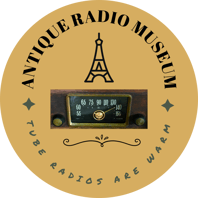Metal Cased Radios
Radio cases are made out of many types of material but one of the early popular materials was metal. However, metal ran the risk of shocking people if an electrical wire came in contact with the metal cabinet.
Atwater Kent made numerous models of metal cabinet radios, as did many other manufacturers. I have heard that AK was the pioneer in this style of cabinet construction. Also, some painted metal cabinets were similar in design to the small plastic cabinet radios. I have one that I call my "toaster" radio because its shape makes it look like an electric toaster. Maybe I should paint in two black slots on the top to make it look even more like a toaster. Also, metal cabinets were used in some of the early portable radios, but don't ask me why because I don't know. One thing is for sure, you won't find any recent vintage metal cabinet radios, unless they are made from plastic to look like metal.


This is the Atwater Kent model 55 radio with "matching" type F-4 dynamic speaker from 1929.
Most of the radios from the 20's had a separate speakers and separate power supplies, sometimes batteries.
Here is the first of my metal radios. Atwater Kent pioneered this type of cabinet and many others followed. You may find broken cabinets on the wooden radios but I have never seen a "broken" cabinet on this type. Dented, maybe, but not broken...hahaha.
This radio operates on AC line voltage while many of the early AK radios needed external batteries to make them play.
You can see that my speaker grill cloth has a small hole in it. Another of my TO DO jobs for the future.
This radio is over 90 years old AND IT STILL WORKS. I do need to do some work to get it working better but I can get 3-4 stations, just not real loud. I think a better antenna would make a world of difference.
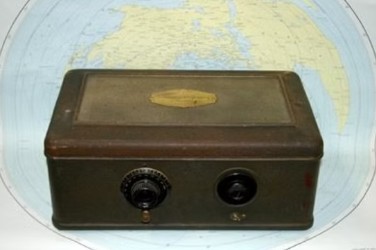

This is another classic Atwater Kent metal case radio, model 40 from 1928.
Like the AK-55 above, this is a TRF set with a single tuning knob. You can see TRF sets in which each stage had its own tuning knob on my "wood radio" page.
I think my roots of loving antique radios dates back to my brother finding an Atwater Kent radio in his basement. It was an earlier version than this because it had 3 separately tuned stages (TRF) and a magnificent speaker whose cone was made out of wood veneer. I don't remember the model of that radio, but I left it with my dad when I went into the army and when I came home on leave he informed me that he had "thrown out that old piece of junk". I was heart broken, but what could I do? However, that was the seed that was planted way back in the mid 50's and it didn't start bearing fruit until I retired many years later.

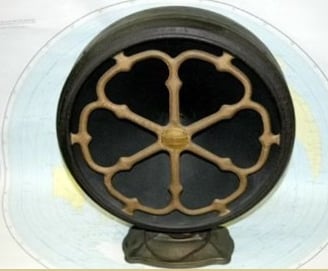
The AK-40 drove a Type-E speaker such as this.
These were heavy so I bet they didn't move around the house very much. You can imagine the entire family gathered around a speaker such as this while they were listening to programs such as Amos and Andy and many others of that period.
This radio is from around 1928 and the model 40 was a very popular radio. (Art tells me 1 million of these models were made so you may know someone who has one of these.) Some of these radios were built into extremely fine crafted wood cabinets that made a striking piece of furniture that was usually placed at the center of focus in the living room.
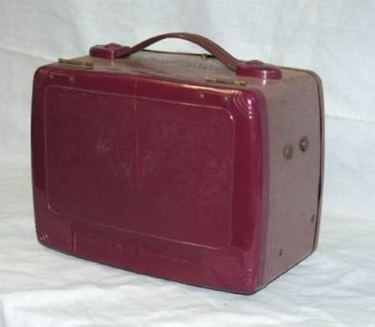

This is a Gerod Metal Portable Radio model 5D-5 from 1948.
This is interesting in that it is made out of metal. This is a picture of the front of the radio with the cover closed. These radios were designed to run on either battery or off of an AC outlet in the house. The back cover opens to reveal the battery compartment and a place to store the power cord.
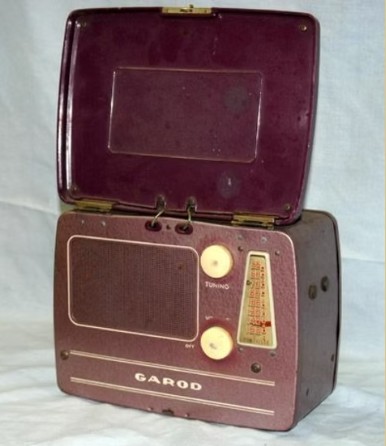

Here is what the radio looks like with its lid open.
It is not much to look at, is it? Notice the two wires that go into the lid. These go to a loop antenna that is embedded there. BTW, this cover is made out of plastic so it doesn't shield the radio waves getting to the loop antenna. I thought it makes the radio look ugly with the lid standing straight up like that, but it makes sense when you think about the lid housing an antenna.
The back cover is metal like the rest of the radio. There isn't much to like about this radio, but I do like the tapered design of the radio dial scale on the right hand side. It almost makes it look like a musical instrument, you know the one I mean...hahaha....I can't spell it.
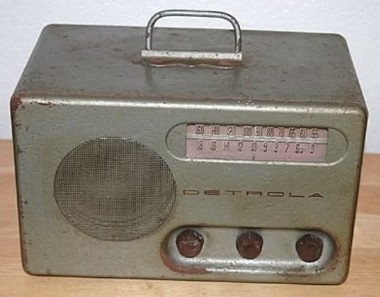

This is a Detrola 568-1 Radio from 1946
It is a AM broadcast band only. This radio was designed to run on 115 volts AC or DC. That's right....DC. It was not designed to run from batteries, but from the mains in areas where their supply voltage was DC and not AC. Therefore the radio does not have a power line transformer. The AC goes directly to the circuit.
I was a little surprised to find this out because when you lift the radio it is very heavy. Usually the weight in a radio is caused by the power supply transformer, and maybe the audio transformer. However, this radio is all steel cabinet and a steel chassis which probably accounts for the weight.
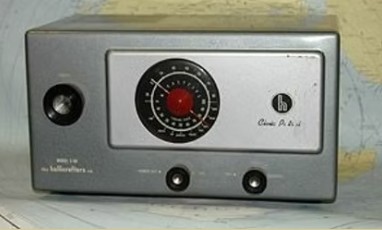

This is a very clean Hallicrafters S-94 Civic Patrol radio. Produced from 1955 - 1962
This radio covers 30 - 50 Mc and has 8 tubes.
I just recently acquired this so I have not checked it out. If the electronics are as good as the cosmetics then it should be a very good radio.

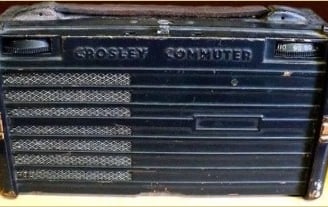
This Crosley Commuter portable radio is in an all metal case.
You can see that the case is in need of refinishing and the front cover is missing. It is an AM only radio, but you might think FM based on the numbers you can see on the dial. Those numbers really represent 800-900-1100 on the AM scale.
This was once a very handsome radio, with a gold strip going around the entire midsection of the radio.
